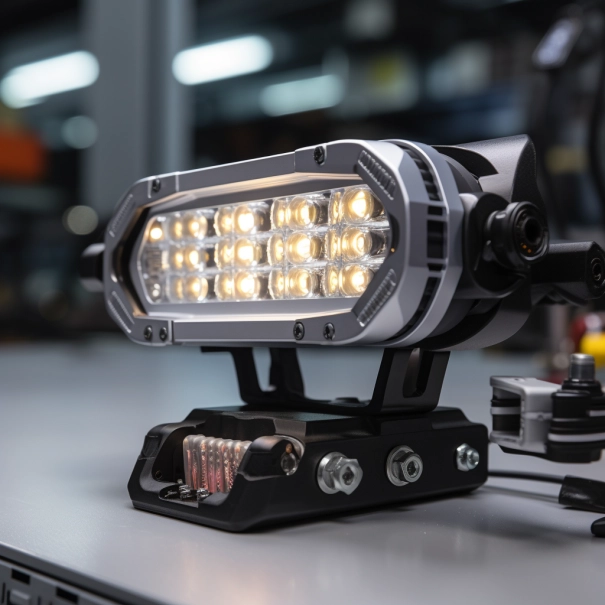In Hongjin, I’ve seen firsthand the evolution of lighting technology. Especially in the realm of industrial and work lighting, the shift from traditional options to LED work lights has been nothing short of revolutionary. LED work lights offer unparalleled advantages, including superior energy efficiency, longer lifespan, and enhanced durability. These benefits are not just numbers on paper; they translate into significant cost savings and operational efficiencies for businesses. But why exactly are LED work lights a game-changer? Let’s delve deeper into this illuminating subject.

What Makes LED Work Lights So Efficient?
The most compelling arguments for LED work lights is their unparalleled energy efficiency. Traditional lighting, like halogen lamps, operate at lower efficiency levels, turning much of the energy they consume into heat rather than light. This inefficiency is not just wasteful; it’s costly. Compared to traditional lighting options, LED lights can convert electricity into light with high efficiency of up to 90%, significantly reducing energy consumption. This means that LED work lights can save businesses a substantial amount on their energy bills. A detailed analysis on energy.gov illustrates that LEDs use at least 75% less energy than incandescent lighting, leading to significant savings.
| Type | Efficiency (lm/W) | Electrical Conversion Efficiency | Optical Conversion Efficiency | Power Conversion Efficiency |
|---|---|---|---|---|
| LED | 80 | 95% | 85% | 90% |
| Fluorescent | 80 | 65% | 60% | 60% |
| Incandescent Bulbs | 20 | —— | 60% | 60% |
How Durable Are LED Work Lights?
Durability is another area where LED work lights outperform traditional lighting.While traditional light bulbs might last for about 1,000 to 2,000 hours, LED lights can last for up to 50,000 hours. On average, an LED light can last up to 25 times longer than incandescent lights. This not only reduces the frequency of replacements but also the maintenance costs associated with lighting in commercial and industrial settings. For businesses operating in demanding environments, this can mean less downtime and more productivity. The U.S. Department of Energy highlights that LED lighting can have a lifespan of 25,000 to 100,000 hours or more, which dwarfs the 1,000-hour average lifespan of traditional incandescent bulbs.
To illustrate this, let’s compare the average lifespans of LED work lights with traditional lighting options:
| Lighting Type | Average Lifespan (Hours) | Notes |
|---|---|---|
| LED Work Light | 25,000 – 100,000 | Highly durable, with a lifespan up to 100 times longer than some traditional options. |
| Incandescent Bulbs | 1,000 – 2,000 | Short lifespan due to filament wear. |
| Halogen Lamps | 2,000 – 4,000 | Slightly better than incandescent, but far behind LEDs. |
| Compact Fluorescent (CFL) | 8,000 – 15,000 | Better than incandescent and halogen, but still significantly less durable than LEDs. |
This comparison showcases the remarkable longevity of LED lighting solutions. It’s clear that in terms of durability, LED work lights are the superior choice.
Are LED Work Lights Cost-Effective?
When evaluating the cost-effectiveness of LED work lights, it’s crucial to look beyond the initial purchase price. The true value of LED lighting lies in its long-term savings and operational efficiencies. Let’s break down the cost-effectiveness of LED work lights into three key areas: energy savings, maintenance savings, and productivity improvements.
Energy Savings
One of the most compelling reasons to switch to LED work lights is the significant energy savings they offer. LED lights consume up to 80% less energy than traditional incandescent bulbs and about 50% less than fluorescent lights. This difference can lead to substantial cost savings over time. For example, replacing ten 100-watt incandescent bulbs with LED equivalents could save over $1,000 in energy costs over the lifespan of the LED bulbs.
Maintenance Savings
LED work lights boast a significantly longer lifespan compared to traditional lighting options. With average lifespans ranging from 25,000 to 100,000 hours, the need for frequent replacements is drastically reduced. This longevity translates directly into savings on maintenance and replacement costs. Considering the cost of purchasing new bulbs and the labor involved in replacing them, these savings can be substantial, especially for large-scale operations.
Productivity Improvements
Another aspect of cost-effectiveness that is often overlooked is the impact of lighting quality on worker productivity. LED work lights provide bright, high-quality light that closely mimics natural daylight, which has been shown to improve worker efficiency and reduce errors. Moreover, the reduced need for maintenance means less downtime and disruption to workflow, further enhancing productivity.
In conclusion, when you combine the energy and maintenance savings with the potential productivity gains, the cost-effectiveness of LED work lights becomes clear. While the initial investment may be higher, the long-term benefits far outweigh the initial costs, making LED work lights a smart choice for businesses looking to optimize their operations.
To put this into perspective, consider a scenario where improved lighting quality leads to a modest 2% increase in productivity. For a business with a monthly payroll of $50,000, this improvement translates to an additional $1,000 worth of productivity per month.
What About the Quality of Light?
Quality of light is crucial in work environments to ensure safety and productivity. LED work lights provide a bright, clear light that closely mimics natural daylight. This can enhance visibility and reduce eye strain, making them ideal for work environments. Moreover, LEDs offer better control over lighting conditions, including color temperature and brightness, allowing for dimming and directional light, improving the adaptability of lighting to specific tasks or preferences. This is not always possible with traditional lighting.
Here’s a comparison that illustrates the difference in light quality:
| Feature | LED Work Lights | Incandescent Bulbs | Fluorescent Lights |
|---|---|---|---|
| Color Rendering Index (CRI) | 80-95 | 100 | 50-80 |
| Color Temperature | 2,700 – 6,500K | 2,700K | 2,700 – 6,500K |
| Luminous Efficacy (Lumens/Watt) | 80-100 | 10-17 | 35-55 |
| Directionality | Directional | Omnidirectional | Omnidirectional |
| Dimmability | Fully Dimmable | Dimmable (not efficient) | Not always dimmable |
Can LED Work Lights Withstand Rough Conditions?
Industrial and construction settings can be harsh, and lighting equipment needs to be able to withstand these conditions. LED work lights are built to be robust and resistant to shock, vibrations, and external impacts. This durability makes them ideal for use in demanding environments where reliability is critical.
What About Environmental Impact?
As a company committed to sustainability, we recognize the importance of reducing environmental impact. LED lights are a more sustainable option compared to traditional lighting solutions. They consume less power, have a longer lifespan, and are free from toxic elements such as mercury. This not only reduces their environmental impact during use but also makes them easier to dispose of or recycle, less waste ends up in landfills. The Environmental Protection Agency’s ENERGY STAR program provides resources on the environmental benefits of LEDs, highlighting their role in reducing greenhouse gas emissions
Conclusion
Opting for LED work lights over traditional lighting is a forward-thinking choice that aligns with modern business values of efficiency, sustainability, and cost-effectiveness. At Hongjin, we are dedicated to providing top-quality LED work lights that meet the needs of businesses looking to improve their operational lighting. With LED technology, companies can not only enjoy superior lighting but also contribute to a more sustainable and efficient future.
Incorporating LED work lights into your operations isn’t just an upgrade—it’s a strategic move towards a brighter, more sustainable business model.




